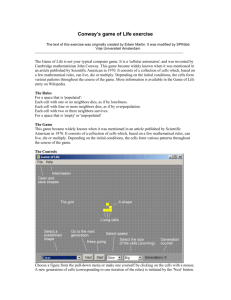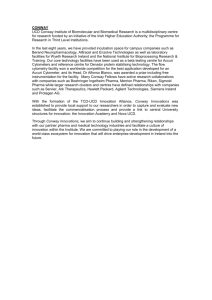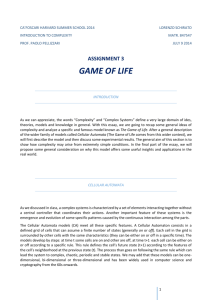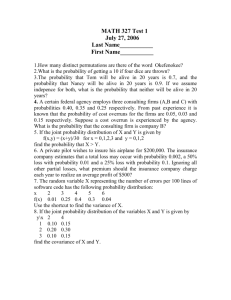Yet another Implementaion of Conway*s Game of life
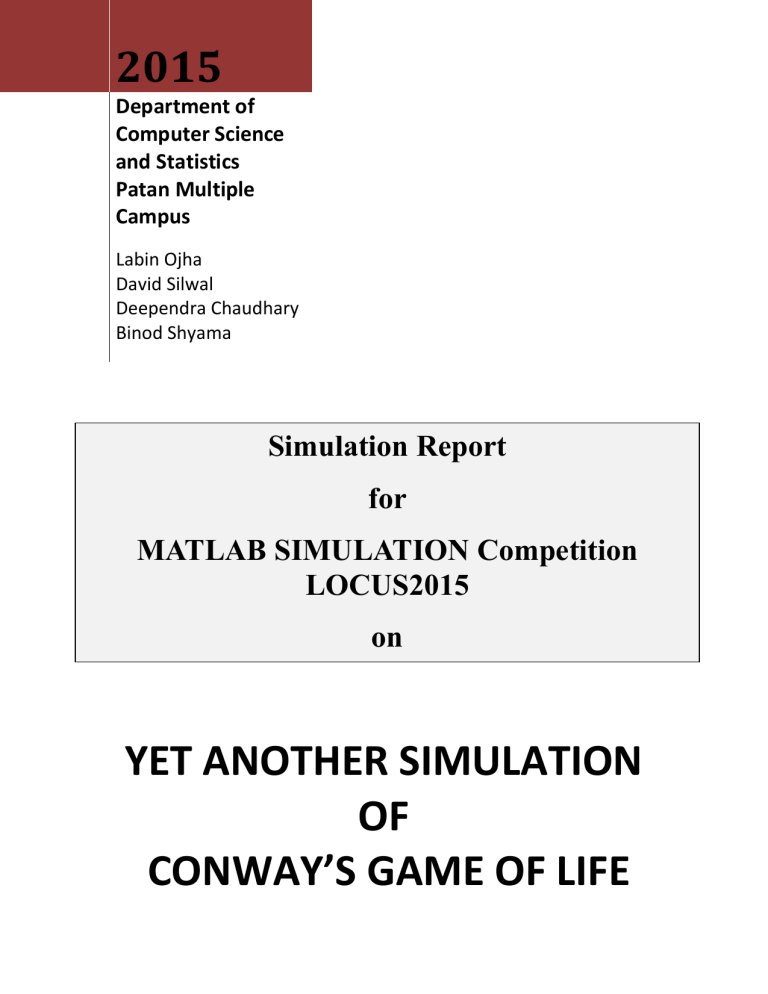
2015
Department of
Computer Science and Statistics
Patan Multiple
Campus
Labin Ojha
David Silwal
Deependra Chaudhary
Binod Shyama
Simulation Report for
MATLAB SIMULATION Competition
LOCUS2015 on
YET ANOTHER SIMULATION
OF
CONWAY’S GAME OF LIFE
Abstract
The goal of our project is to design a visualization of the Game of Life as described by John Horton Conway. It is one of the best examples in science of how a few simple rules can result in incredibly complex behavior. It’s also incredibly cool and gorgeous to watch. The Game of Life, actually not a game, but more of an algorithm is meant to show what happens to organisms when they are placed in close proximity to each other. Upon giving the Game initial conditions, each successive ‘generation’
(iteration) shows the evolution of the organisms.
Introduction
The Game of Life, invented by John Conway in 1970, is an example of a zeroplayer “game” known as a cellular automaton. The game consists of a two-dimensional world extending infinitely in all directions, divided into “cells.” Each cell is either “dead” or “alive” at a given “generation”. The game consists of a set of rules that describe how the cells evolve from generation to generation. These rules calculate the state of a cell in the next generation as a function of the states of its neighboring cells in the current generation. In a 2-D world, a cell’s neighbors are those 8 cells vertically, horizontally, or diagonally adjacent to that cell. Conway’s set of rules are summarized as:
1. A live cell with fewer than two live neighbors dies.
2. A live cell with more than three live neighbors also dies.
3. A live cell with exactly two or three live neighbors lives.
4. A dead cell with exactly three live neighbors becomes alive.
In this matlab, we will be implementing Conway’s Game of Life, with the minor restriction that our 2-D world is finite.
History
The British mathematician John Conway, who is currently at Princeton University, invented the Game of Life in the late 1960s. He chose rules that produced the most unpredictable behavior.
Examples of Patterns
Many different types of patterns occur in the Game of Life, including still life, oscillators, and patterns that translate themselves across the board ("spaceships").
Some frequently occurring examples of these three classes are shown below, with live cells shown in black and dead cells shown in white.
Implementation in Matlab
The Game of Life, which is implemented in MATLAB, fairly straightforward and the other an attempt to make it as small as possible.
Game of Life, is implemented as follows:
Use an n x n grid.
Initial random distribution of cells.
Periodic boundary conditions to make it "Infinite".
Uses matrices to represent the grid.
Loop over the life time- number of iterations.
Count neighbors for each element (cell) in the matrix.
Uses the "spy" or "pcolor" function to plot (re-plot) the matrix every iteration.
Source Code
function gameOfLife(gridSize, runGenerations, delay, name)
% Default pattern to load
if (isempty(name))
name = 'gosper';
end
format bank;
% Initialize a sparse matrix of dimensions gridSize by gridSize
M = sparse(gridSize, gridSize);
origX = round(gridSize/2);
origY = round(gridSize/2);
%Insert initial pattern
[P, nameLife] = lexicon_read(name);
[offsetX, offsetY] = size(P);
M([origX+1:(origX+offsetX)], [origY+1:(origY+offsetY)]) = P([1:end], [1:end]);
% Initialize variables
gen = 0; % generations counter
counter = 0;
alive = 0;
fig = figure;
fig.NumberTitle = 'off';
fig.Name = ' Game of Life ';
% Loop to generate life successions
while (counter <= runGenerations)
% Visualize the sparse matrix in a 2D grid with 1 and 0
% representing different colours
colormap(bone);
spy(M);
title(['Name of Pattern: ', nameLife ' | Generations: ', num2str(gen) ...
' | Cells: ', num2str(alive) ' | Density: num2str(alive*100/gridSize^2) '%']);
drawnow;
pause(delay);
% Counting neighbours for each cell
n = size(M, 1);
offset1 = [2:n 1]; % The world
offset2 = [n 1:n-1]; % is continuous
%offset1 = [1 1:n-1]; % The world
%offset2 = [2:n n]; % is bounded
',
N = M(:, offset1) + M(:, offset2) + M(offset1, :) + M(offset2, :) +
M(offset1, offset1) + M(offset2, offset2) + M(offset1, offset2) + M(offset2, offset1);
% Elements in the map matrix 'M' is set to 1(i.e alive) only if sum
% of neighbouring elements is either 2 or 3
M = (M & (N == 2) | (N == 3));
% Counter variables
counter = counter + 1;
gen = gen + 1;
alive = nnz(M);
end
% Cleanup
clear,clc; end % gameOfLife
RESOURCES
Computer:
Type: ACPI x64-based PC (Mobile)
Motherboard: Acer Aspire 4830TG
CPU: DualCore Intel Core i5-2450M, 2500 MHz (25 x 100) 64-bit
Video Adapter: Intel(R) HD Graphics 3000 (1890230 KB)
Video Adapter: NVIDIA GeForce GT 540M (1 GB)
Memory: 4.00 GB
Operating system:
Windows 8.1 Pro 64-bit Operating system
Computational package / Software used:
MATLAB R2014b for the programming and simulation
MS - Office 2007 to prepare companion Docs
Help and references used: http://ocw.mit.edu/courses/mathematics/18-s997-introduction-to-matlabprogramming-fall-2011/conway-game-of-life/conway-game-of-life-implementation/ http://en.wikipedia.org/wiki/Conway%27s_Game_of_Life/ http://www.argentum.freeserve.co.uk/lex_home.htm http://blogs.mathworks.com/cleve/2012/09/03/game-of-life-part-1-the-rule/
CONCLUSION
The Game of Life was successfully implemented in MATLAB.
